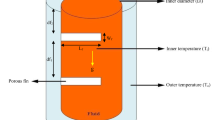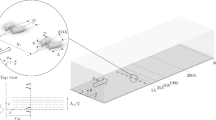Abstract—
Local flow swirling is used in power facilities and other technical devices. It is an effective means for acting on the air flow structure and can enhance heat transfer. A swirled flow in axisymmetric channels belongs to the group of 3D flows in the field of centrifugal mass forces. It is characterized by the ratio of two (axial and rotational) or, in some cases, three components of the velocity, the presence of transverse and longitudinal pressure gradients, and high turbulent fluctuations that bring about certain difficulties in the investigation of processes occurring in a swirled flow and it complicates detection of their regularities. Therefore, it is proposed to install a vortex chamber (VC) at the leading edge of a blade or vane of a high-temperature gas turbine. Temperature conditions and flow capacity of VC models were studied by a calorimetric method in a liquid-metal thermostat. The regularities of heat transfer rate on the surface of the cooling channels were determined depending on the number and diameter of inlet (supply) and outlet holes for various pressure drops. The VK designs were optimized considering the effect of their geometry on the formation of various swirl flow structures with different levels of heat transfer enhancement. An analysis was performed with account taken of the throughput capacity of the models. The criterial dependences of the Nusselt number vs. Reynolds number Re were obtained for three VC designs for direct- or reverse-flow direction. The highest heat fluxes were observed on the section of coolant supply via holes, which is explained by a high velocity of the initial flow swirling. Flow swirl breakage and cooling air heating are the cause of a decrease in the relative heat transfer coefficient \({\bar {\alpha }}{\text{.}}\) The self-similarity mode is observed at a pressure ratio across the vortex chamber above 1.4. The thermal problem was solved using data of the hydraulic tests of the models with air blowing under isothermal conditions. The results of experimental studies can be included in the data bank of heat and mass transfer software products to reduce the labor intensity and time in the development of a cooling system for blades/vanes of high-temperature gas turbines.







Similar content being viewed by others
REFERENCES
V. K. Shchukin, Heat Transfer and Hydrodynamics of Internal Flows in the Fields of Mass Forces (Mashinostroenie, Moscow, 1980) [in Russian].
A. R. Lyandzberg and A. S. Latkin, Vortex Heat Exchangers and Condensation in the Vortex Flow (Kamchatskii Gos. Tekh. Univ., Petropavlovsk-Kamchatskii, 2004) [in Russian].
A. S. Latkin, “The study of convective heat transfer in the models of vortex chambers,” Vestn. Kamchatskogo Gos. Tekh. Univ., No. 4, 90–96 (2005).
Yu. L. Leukhin and E. N. Saburov, “The study of aerodynamics and heat transfer in the annular channels of cyclone recuperators,” Sovrem. Nauka: Issled., Idei, Rezul’taty, Tekhnol., No. 1, 123–129 (2013).
S. V. Veretennikov and S. M. Khasanov, “Investigation of the thermal state of a nozzle blade with a vortex cooling system,” Vestn. Samar. Gos. Aerokosm. Univ., No. 3, 323–328 (2011).
F. V. Pelevin, N. L. Yaroslavtsev, A. V. Vikulin, S. A. Orlin, and A. V. Ponomarev, “Investigation of heat transfer efficiency in coplanar channels,” Therm. Eng. 62, 190–195 (2015). https://doi.org/10.1134/S0040601515030076
A. V. Vikulin, N. L. Yaroslavtsev, and V. A. Zemlyanaya, “Study of heat exchange in cooling systems of heat-stressed structures,” Therm. Eng. 64, 32–36 (2017). https://doi.org/10.1134/S0040601517010104
A. V. Vikulin, N. L. Yaroslavtsev, and V. A. Chesnova, “Diagnostics of efficiency for a cooling system of compact heat exchangers with coplanar channels,” Russ. Aeronaut. 59, 395–401 (2016). https://doi.org/10.3103/S1068799816030168
A. V. Vikulin, N. L. Yaroslavtsev, and V. A. Chesnova, “Development of the design scheme of cooling for a nozzle vane of high pressure turbine of gas turbine engine,” Russ. Aeronaut. 59, 58–63 (2016). https://doi.org/10.3103/S1068799816010098
A. V. Vikulin, N. L. Yaroslavtsev, and V. A. Zemlyanaya, “Estimation of efficiency of the cooling channel of the nozzle blade of gas-turbine engines,” Therm. Eng. 65, 88–92 (2018). https://doi.org/10.1134/S0040601517120102
V. G. Popov, A. V. Vikulin, N. L. Yaroslavtsev, and V. A. Chesnova, “Technique for determination of the thermal-physical parameters affecting relative cooling depth of gas turbine blades,” Aviats. Prom-st., No. 3, 20–24 (2012).
A. V. Vikulin, N. L. Yaroslavtsev, and V. A. Chesnova, “Methodology for the heat design of the cooled gas turbine blades of gas turbine engines and gas turbine installations,” Nauchn. Mysl’, No. 1, 86–105 (2016).
V. G. Popov, A. V. Vikulin, V. A. Chesnova, and M. S. Markelov, “Effect of geometrical characteristics of the complex-shaped channels on the multi-parametric functions of heat exchange,” Aviats. Prom-st., No. 1, 17–20 (2013).
V. G. Popov, A. V. Vikulin, V. A. Chesnova, and M. S. Markelov, “Analysis of the possibility to expand the control range of complex-shaped channel capacity of heat-stresses structures,” Aviats. Prom-st., No. 2, 25–29 (2013).
V. I. Lokai, V. M. Bodunov, V. V. Zhuikov, and A. V. Shchukin, Heat Transfer in Cooled Parts of Aircraft Gas Turbine Engines (Mashinostroenie, Moscow, 1985) [in Russian].
S. Z. Kopelev and S. V. Gurov, Thermal State of Aircraft Engine Structure Elements (Mashinostroenie, Moscow, 1978) [in Russian].
Author information
Authors and Affiliations
Corresponding author
Additional information
Translated by T. Krasnoshchekova
Rights and permissions
About this article
Cite this article
Vikulin, A.V., Yaroslavtsev, N.L. Investigation of Thermohydraulic Characteristics of Vortex Chambers. Therm. Eng. 67, 554–559 (2020). https://doi.org/10.1134/S004060152008008X
Received:
Revised:
Accepted:
Published:
Issue Date:
DOI: https://doi.org/10.1134/S004060152008008X




